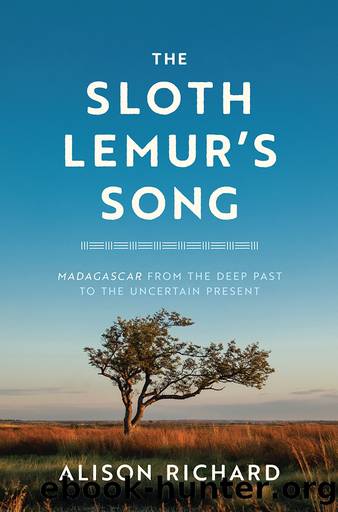The Sloth Lemur's Song by Alison Richard

Author:Alison Richard
Language: eng
Format: epub
Publisher: University of Chicago Press
Published: 2022-01-15T00:00:00+00:00
Drier periods (shaded), fire peaks (^^^^^^) and vegetation changes in the southeast over the last 6,000 years (adapted from Virah-Sawmy et al. 2010)
The earliest evidence of cattle in Madagascar comes from bones tossed into tenth-century rubbish pits excavated in the far south, and the south is cattle country par excellence today. It should be a good region to investigate the role of introduced livestock in landscape change, although in practice this has been little studied anywhere in Madagascar. The interacting effects of rainfall, soil and grazing pressure on vegetation around a great lake in the southwest have been examined in a recent study, however. The vegetation there is a mix of dry and spiny forest. Pastoralism is not an easy occupation anywhere in the south. The dry season is long, and rains are unpredictable and fail completely in some years. Cattle need to drink, their daily range constricts as free-standing water dries up, and many herbaceous plants in the forest are of poor value as forage. Added to this, the national park established around the lake some years ago is formally off-limits for livestock, and has certainly disrupted the annual cycle of herd movements.
Local livestock owners faced with these challenges drive their cattle herds east of the lake across a high limestone plateau to extensive grasslands beyond, where they spend much of the wet season grazing. Toward the seasonâs end, the limited water sources begin to dry up and cattle are moved back west to browse on woody forest plants. Although the forage is poor, a few pools of water persist in this area, even at the height of the dry season. Goats, on the other hand, are kept year-round on the sandy soils of the lakeâs western, coastal flank.
Against this backdrop of complex husbandry strategies, researchers examined the number and diversity of plant species in 66 plots established west of the lake on different soils and subjected to varying levels of grazing and browsing. They found significantly fewer plant species and fewer woody plants in sandy coastal plots exposed to intense grazing and browsing. Yet these differences were not found in vegetation on limestone substrates that were also intensely grazed and browsed. Does substrate affect impact? More work is needed to know. Grazing and browsing in and of themselves are not the only issue, moreover. Annual fires set by herders to give cattle a âgreen biteâ kill some trees and eat away at forest edges. Yet the most resilient species persist and todayâs swathes of forest in the south, where cattle have browsed and grazed longest, suggest that their long-term impact has been limited.
The journal of a shipwrecked English sailor offers an intriguing historical perspective. Robert Drury was aboard the ship Degrave when it broke up on a reef somewhere along the south coast of Madagascar in 1703. He made it ashore and spent the next 13 years as a quasi-slave before escaping, returning safely to London, and publishing his journal in collaboration with Daniel Defoe. Some have questioned its authenticity, but I share Alison Jollyâs view: â.
Download
This site does not store any files on its server. We only index and link to content provided by other sites. Please contact the content providers to delete copyright contents if any and email us, we'll remove relevant links or contents immediately.
The Lonely City by Olivia Laing(4751)
Animal Frequency by Melissa Alvarez(4395)
All Creatures Great and Small by James Herriot(4233)
Walking by Henry David Thoreau(3895)
Exit West by Mohsin Hamid(3778)
Origin Story: A Big History of Everything by David Christian(3651)
COSMOS by Carl Sagan(3559)
How to Read Water: Clues and Patterns from Puddles to the Sea (Natural Navigation) by Tristan Gooley(3409)
Hedgerow by John Wright(3278)
The Inner Life of Animals by Peter Wohlleben(3261)
How to Read Nature by Tristan Gooley(3250)
How to Do Nothing by Jenny Odell(3235)
Project Animal Farm: An Accidental Journey into the Secret World of Farming and the Truth About Our Food by Sonia Faruqi(3178)
Origin Story by David Christian(3149)
Water by Ian Miller(3129)
A Forest Journey by John Perlin(3027)
The Plant Messiah by Carlos Magdalena(2883)
A Wilder Time by William E. Glassley(2818)
Forests: A Very Short Introduction by Jaboury Ghazoul(2790)
